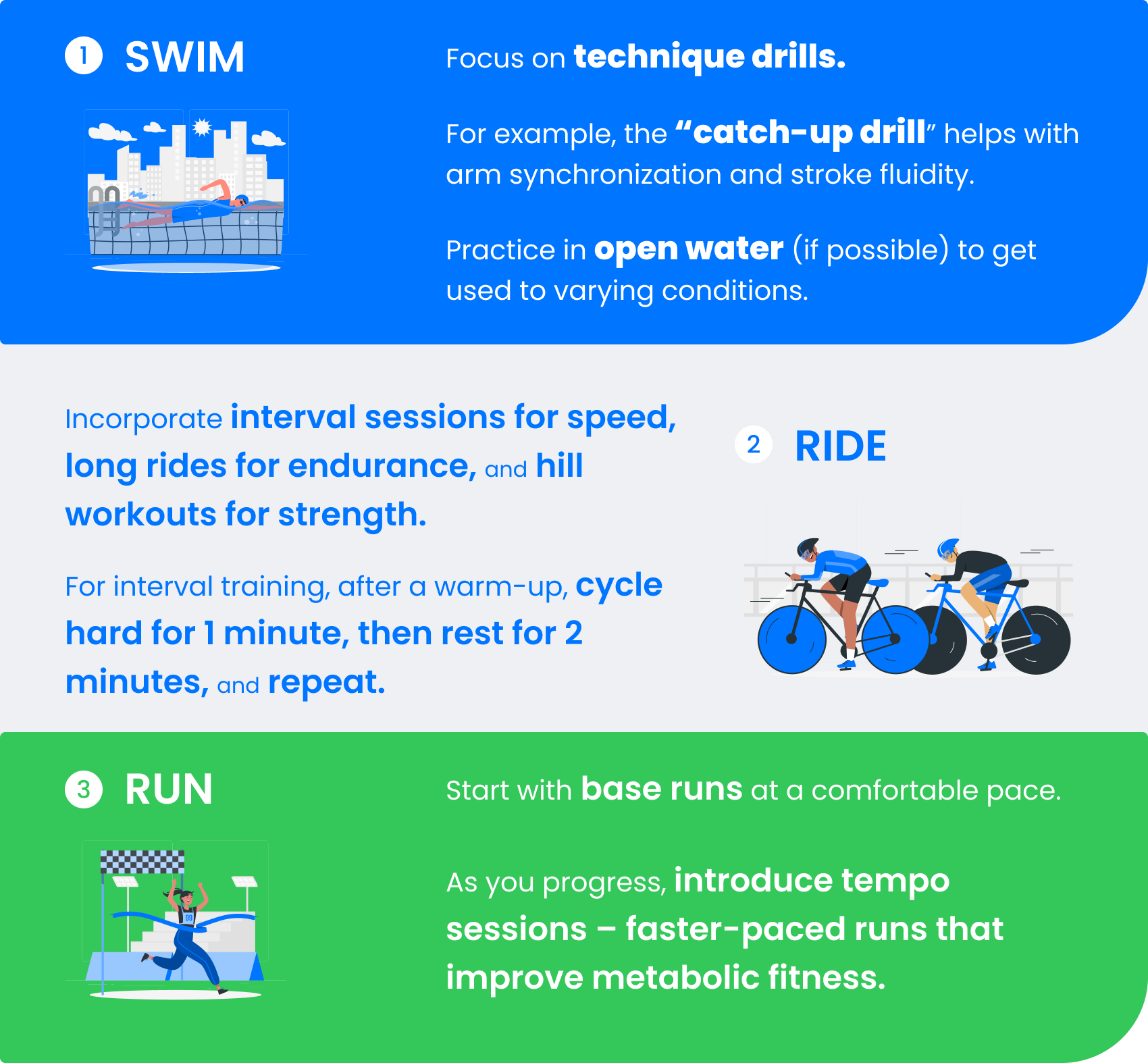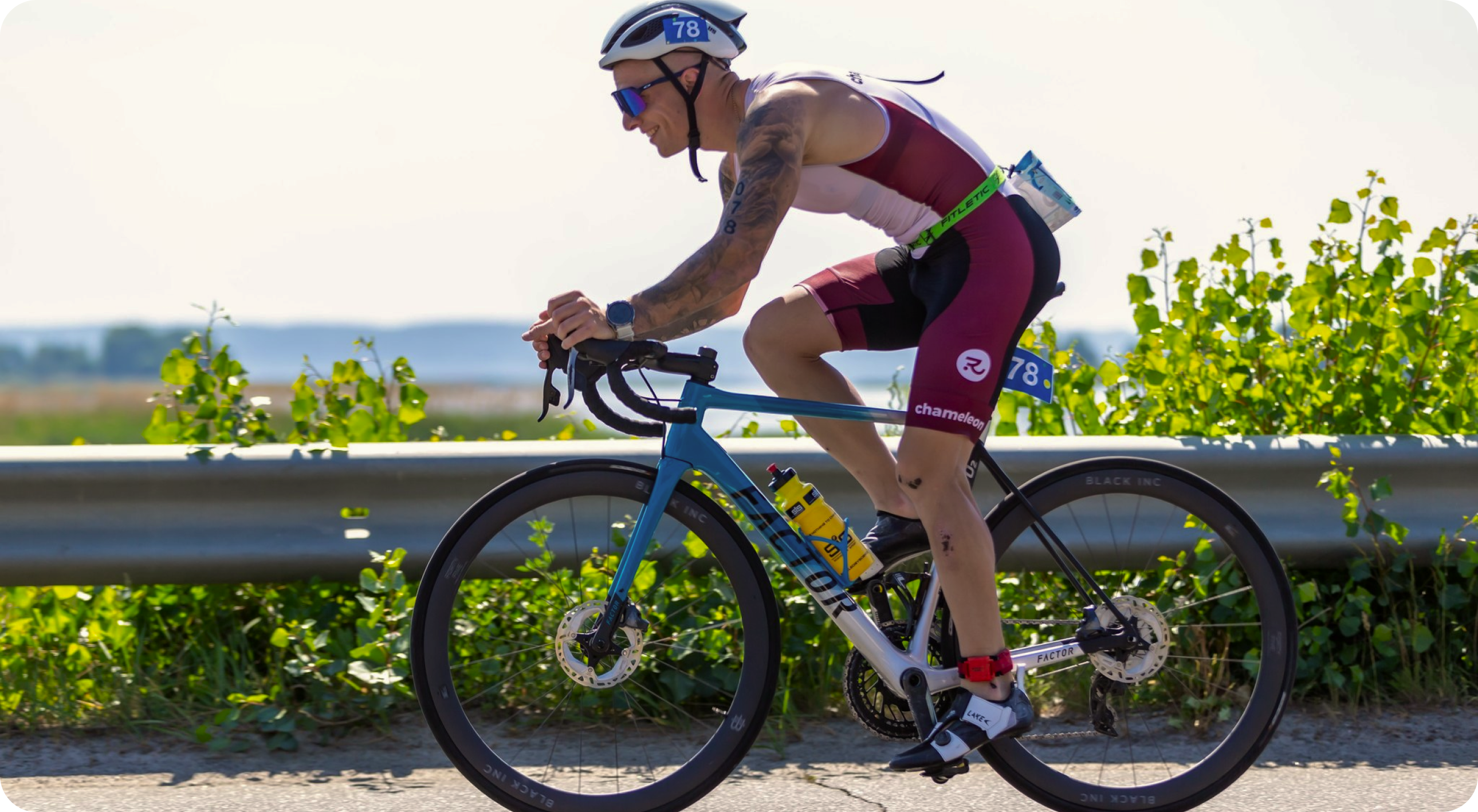A triathlon is a test of endurance, skill, and mental fortitude.
Embarking on the journey of preparing for one, especially if it’s your first race, is as thrilling as it is challenging.
As with any significant endeavor, success in triathlon hinges largely on planning.
Let’s dive into the essentials of creating the first triathlon training plan tailored to your needs.
Understanding the Basics of Triathlon Training
Triathlon, at its core, comprises three disciplines: swimming, cycling, and running.
Each has its unique challenges, and to be successful, it’s imperative to train effectively for all three.
1. Different distances.
Whether you’re gearing up for a Sprint, Olympic, Half Ironman plan, or the full Ironman distance, each race demands different training strategies.
For instance, a Sprint distance triathlon, being the shortest, may demand more speed-based training, while an Ironman would focus on endurance, strength training, and longer racing.
2. Determining Your Starting Point and Goals
Before diving headfirst into training, you must evaluate where you stand as a beginner triathlete.
- Identify your general fitness levels: Understand your baseline.
Can you swim a few pool lengths without fatigue?
How far can you run or cycle?
Knowing this helps tailor your plan to your level.

Setting SMART goals
Renowned philosopher Seneca once said, “If one does not know to which port one is sailing, no wind is favorable.”
Setting SMART goals ensures you have a clear vision.
For instance, instead of “I want to complete a triathlon,” aim for “I want to complete a Sprint triathlon in 1 hour and 30 minutes by October.”
3. Building Your Weekly Training Structure
Structured training is the bedrock of triathlon success.
- Periodization
This involves breaking down your training into specific training zones, each with a particular goal.
Whether it’s building a base, working on speed, or tapering down for race day, each phase has a purpose.
- Structuring a basic week
For triathlon beginners, a balanced week might include three bike sessions, three runs, and two swims.
This isn’t set in stone.
It’s about finding what works for you.
Remember to sprinkle in rest days; they’re when your body recovers and gets stronger.
4. Designing Workouts for Each Discipline
Here’s where the rubber meets the road, or rather, where the swim cap, cycling cleats, and running shoes get into action.
Swimming
Focus on technique drills.
For example, the “catch-up drill” helps with arm synchronization and stroke fluidity.
Additionally, practice in open water (if possible) to get used to varying conditions.
Bike ride
Incorporate interval sessions for speed, long rides for endurance, and hill workouts for strength.
For instance, for interval training, after a warm-up, cycle hard for 1 minute, then rest for 2 minutes, and repeat.
Running
Start with base runs at a comfortable pace.
As you progress, introduce tempo sessions – faster-paced runs that improve metabolic fitness.
Brick workouts, where you cycle and then run immediately after, are also beneficial, preparing you for the unique feeling of transitioning during the race.

5. Balancing Intensity and Volume when Training for Your First Triathlon Race
When training for your first triathlon race, it’s important to strike a balance between intensity and volume to optimize your performance and minimize the risk of injury or burnout.
It’s a delicate dance between pushing hard and pushing too hard.
- Relationship between intensity and volume
As a rule, when one goes up, the other should come down. If you’re doing a high-intensity interval session, the overall volume (or duration) should be less than a longer, steadier workout.
- Signs of overtraining
Feeling consistently tired, mood swings, disturbed sleep, and persistent soreness are red flags. Listening to your body is paramount.

6. Importance of Nutrition and Recovery in Your Training Plan
Nutrition and recovery are essential components of any training plan, including when preparing for your first triathlon race.
Just as a car runs best with quality fuel, your body needs the right nutrition.
- Fueling your workouts
Eating the right foods at the right times can provide the energy your body needs to perform optimally during training sessions.
- Pre-workout nutrition
Aim to eat a balanced meal containing carbohydrates, protein, and healthy fats 2-3 hours before your workouts.
Carbohydrates are particularly important as they provide the primary fuel source for endurance exercise.
Examples of pre-workout meals/snacks include oatmeal with fruit and nuts, a turkey sandwich on whole grain bread, or yogurt with granola.
- During longer sessions
For workouts lasting longer than an hour, especially during intense or prolonged efforts, you may benefit from consuming additional carbohydrates and a sports drink to sustain energy levels.
Energy gels, chews, or sports drinks can be convenient options to fuel your body during these sessions and help delay fatigue.
- Post-exercise nutrition
After completing a workout, your body needs nutrients to replenish glycogen stores, repair muscles, and support recovery.
Aim to consume a combination of carbohydrates and protein within 30-60 minutes post-exercise.
Examples of post-workout snacks or meals include a protein smoothie with fruit, grilled chicken with quinoa and vegetables, or Greek yogurt with honey and almonds.
In addition to proper nutrition, incorporating active recovery strategies into your routine can help enhance recovery, reduce muscle soreness, and prevent injuries.
Here are some examples of recovery strategies:
- Stretching
Gentle stretching exercises can help improve flexibility, reduce muscle tension, and promote relaxation.
Focus on stretching major muscle groups used during your workouts, holding each stretch for 15-30 seconds without bouncing.
- Foam rolling
Using a foam roller or other self-myofascial release tools can help release tight muscles, improve blood flow, and alleviate muscle soreness.
Spend 5-10 minutes foam rolling after your workouts, focusing on areas of tightness or discomfort.
- Adequate sleep
Quality sleep is essential for physical and mental recovery.
Aim for 7-9 hours of sleep per night, prioritizing consistent sleep patterns and creating a relaxing bedtime routine to promote restful sleep.
7. Fine-Tuning: Adjustments and Adaptations
No training plan, no matter how well-crafted, is set in stone.
Adapting to external factors: Maybe work gets hectic, or you catch a cold.
It’s essential to adjust and, at times, take a step back. It’s a marathon, not a sprint (pun intended).
Tools and Resources to Assist in Training Plan Creation
In today’s digital age, there are a lot of triathlon training apps and platforms that assist triathletes in creating and managing their training plans.
These tools offer a range of features, including structured training plans, workout tracking, performance analysis, and goal setting.
Here are a few examples:
TrainingPeaks
TrainingPeaks is a popular platform used by athletes and coaches to plan, track, and analyze workouts. It offers customizable training plans tailored to individual goals, as well as features for monitoring fitness metrics, such as heart rate, power, and pace.
MyProCoach
MyProCoach provides three sports training plans designed by experienced coaches. These plans are available for various distances and skill levels, and they include detailed workouts with specific intensity targets and progress-tracking features.
Strava
While primarily known as a social fitness app for tracking running and cycling activities, Strava also offers training plans and analysis tools for triathletes. It allows you to connect with other athletes, join challenges, and gain insights into your training performance.
Garmin Connect
If you use Garmin fitness devices, Garmin Connect is a comprehensive platform for planning, tracking, and analyzing workouts. It syncs seamlessly with Garmin devices and offers features like training load monitoring, recovery tracking, and workout scheduling.

Hiring a coach
Working with a qualified triathlon coach can provide invaluable support and guidance throughout your training journey, whether for sprint triathlons or an Olympic distance triathlon.
A coach can offer personalized training plans tailored to your individual strengths, weaknesses, and goals.
Here are some more benefits of hiring a coach:
Personalized guidance
A coach can assess your current fitness level, set realistic goals, and design a training plan that fits your schedule and abilities.
Technique refinement
A qualified coach can help you improve your swimming, cycling, and running techniques through drills, feedback, and video analysis.
Accountability
Having a coach to answer to can help keep you accountable and motivated to stick to your training plan, even when motivation wanes.
Race-day preparation
A coach can provide guidance on pacing, nutrition, transition strategies, and mental preparation to help you perform your best on race day.
Embarking on the journey of triathlon training is a transformative experience.
It’s not just about crossing the finish line, but about the lessons learned, the barriers are broken, and the limits pushed “Triathlon doesn’t build character. It reveals it.”
The journey to triathlon greatness is paved with persistence, determination, and consistent effort.

8. Incorporating Feedback: The Path to Continuous Improvement
Just as a sailor adjusts the sails to the changing wind, so must a triathlete refine their training plan based on feedback and experiences.
- Monitoring performance
Regularly checking in on your progress is essential.
Time trials, measuring resting heart rate, and tracking perceived exertion can provide insights into your current fitness level.
- Seeking expert advice
Engage with the triathlon community.
Joining local triathlon clubs or online forums like Slowtwitch can offer a wealth of knowledge from seasoned athletes who’ve been in your shoes.
9. Race Day Simulations: Mimicking the Real Deal
Before the big day, it’s beneficial to have a few trial runs, simulating race conditions as closely as possible.
- Brick workouts
These are especially valuable as they mimic the feeling of transitioning from one discipline to another.
An example could be a 1-hour cycle followed immediately by a 15-minute run.
- Equipment and transition area checks
Use these simulation days to test everything you plan to use on race day – from nutrition to triathlon gear.
Ironman World Champion Chrissie Wellington emphasized the importance of this, saying, “Never try anything new on race day.”
10. Dealing with Setbacks: Building Resilience and Tenacity
Every triathlete, from beginners to elite, faces setbacks. It’s an inevitable part of the journey.
- Recovering from injuries
Prioritize rest and seek medical advice. Remember that an injury is a pause, not a full stop.
- Managing missed workouts
Life happens. If you miss a training session, avoid the temptation to “double up” the next day. Reflect, adjust, and move on.

11. Staying Engaged: Finding Joy in the Process
One can’t stress enough the importance of enjoying the journey.
Training for a triathlon is demanding, but it should also be rewarding.
- Celebrate small wins
Completed a challenging workout? Swam a personal best time?
Celebrate these moments. They are milestones on your journey.
- Engage with fellow triathletes
Share experiences, challenges, race time results, and tips.
As the acclaimed triathlete Craig Alexander said,
“Triathlon for me is not just about a race or about fitness. It’s a lifestyle, a catalyst for everything else.”
In conclusion, building the first triathlon training plan from scratch might seem daunting.
But with the right guidance, dedication, and passion, it becomes an exciting roadmap to success.
The triathlon is as much about the mental game as it is about physical prowess.
By setting clear goals, staying consistent, celebrating small victories, and always being ready to adapt, you’re setting yourself up for not just a successful race day but a rewarding journey of self-discovery and growth.
Dive in, pedal hard, and run your heart out!
Your triathlon journey awaits.





